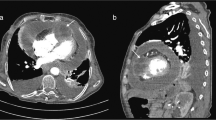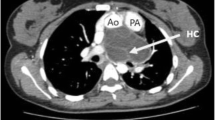Abstract
Hydatid cysts are a serious health problem in many countries that raise farm animals, and they usually involve the liver and lungs. Although cardiac involvement is a rare manifestation of hydatid cyst disease, its early diagnosis and surgical management are crucial. Patients with cardiac hydatidosis may develop acute life-threatening complications secondary to their invasion of surrounding cardiac structures, such as cyst rupture together with systemic and pulmonary dissemination. Therefore, surgical excision is the definitive method of treatment for cardiac hydatid cysts in order to prevent these potential life-threatening complications, even for asymptomatic patients. Herein, we report the case of a 36-year-old man who initially presented with pleuritic chest pain, hemoptysis, and dyspnea. This was followed by the revelation of multiple cardiopericardial hydatid cysts which were discovered via transesophageal echocardiography and multislice computed tomography. In this case, there was a higher risk of cyst rupture and thromboembolism during systemic and pulmonary circulation due to the invasive nature of the cysts which were located in the left atrium as well as between the pulmonary artery and aorta. The patient successfully underwent the removal of the multiple cardiac cysts under cardiopulmonary bypass by taking into account their relationship with the surrounding cardiac structures and the potential risk of local, systemic, and pulmonary dissemination. A pathological evaluation of the surgical specimens confirmed the diagnosis of cardiac echinococcosis and the aggressive nature of the cardiopericardial hydatid cysts by demonstrating their myocardial invasion.
Zusammenfassung
In vielen Ländern, in denen Viehzucht betrieben wird, stellen Hydatidenzysten ein gravierendes Problem dar. Sie manifestieren sich in der Regel in Leber und Lunge. Eine kardiale Beteiligung ist zwar eine seltene Echinokokkosemanifestation, doch die frühe Diagnose und chirurgische Behandlung sind entscheidend. Bei einer kardialen Hydatidose können sich nach Invasion benachbarter kardialer Strukturen akute, lebensbedrohliche Komplikationen entwickeln, etwa eine Zystenruptur mit systemischer und pulmonaler Disseminierung. Um solche potenziell lebensbedrohlichen Komplikationen zu vermeiden, besteht die definitive Therapie der Wahl bei kardialen Hydatidenzysten – auch für asymptomatische Patienten – in der chirurgischen Exzision. Berichtet wird über einen 36-jährigen Mann, der sich initial mit pleuritischen Thoraxschmerzen, Hämoptysen und Dyspnoe vorstellte. Mittels transösophagealer Echokardiographie und in Mehrschicht-Computertomographie-Aufnahmen wurden multiple kardioperikardiale Hydatidenzysten nachgewiesen. Wegen des invasiven Charakters der im linken Atrium sowie zwischen A. pulmonalis und Aorta gelegenen Zysten bestand ein erhöhtes Risiko für eine Zystenruptur und eine Thromboembolie im systemischen und pulmonalen Kreislauf. Die Zysten wurden mit einem kardiopulmonalen Bypass operativ entfernt, dabei wurden ihre jeweiligen Beziehungen zu umgebenden kardialen Strukturen sowie die Risiken für eine mögliche lokale, systemische und pulmonale Streuung berücksichtigt. Die histopathologische Untersuchung der operativ gewonnenen Proben bestätigte die klinische Diagnose einer kardialen Echinokokkose und, über den Nachweis der Myokardinvasion, auch den aggressiven Charakter der Hydatidenzysten.



Similar content being viewed by others
References
Dziri C (2001) Hydatid disease–continuing serious public health problem: introduction. World J Surg 25:1–3
Canpolat U, Yorgun H, Sunman H, Aytemir K (2011) Cardiac hydatid cyst mimicking left ventricular aneurysm and diagnosed by magnetic resonance imaging. Turk Kardiyol Dern Ars 39:47–51
Thameur H, Abdelmoula S, Chenik S et al (2001) Cardiopericardial hydatid cysts. World J Surg 25:58–67
Aksakal E, Değirmenci H, Bakırcı EM, Sevimli S (2011) Symptomatic isolated giant hydatid cyst in the posterolateral region of the left ventricle. Turk Kardiyol Dern Ars 39:740
Altun O, Akalin F, Ayabakan C et al (2006) Cardiac echinococcosis with intra-atrial localization. Turk J Pediatr 48:76–79
Tercan F, Kacar N, Kilic D et al (2005) Hydatid cysts of the bilateral pulmonary arteries and left ventricle wall: computed tomography and magnetic resonance imaging findings. J Comput Assist Tomogr 29:31–33
Biyik I, Acar S, Ergene O (2007) Left atrial mobile hydatid cyst mimicking left atrial myxoma and mitral stenosis and causing heart failure and arrhythmia. Int J Cardiovasc Imaging 23:193–195
Ozer N, Aytemir K, Kuru G et al (2001) Hydatid cyst of the heart as a rare cause of embolization: report of 5 cases and review of published reports. J Am Soc Echocardiogr 14:299–302
Barbetseas J, Lambrou S, Aggeli C et al (2005) Cardiac hydatid cysts: echocardiographic findings. J Clin Ultrasound 33:201–205
Xing Y, Bawudong D, Zhang WB et al (2011) Multidetector CT and MR imaging cardiac hydatidosis: case report and review of the literature. Int J Cardiovasc Imaging 27:97–102
Dursun M, Terzibasioglu E, Yilmaz R et al (2008) Cardiac hydatid disease: CT and MRI findings. AJR Am J Roentgenol 190:226–232
Murat V, Qian Z, Guo S, Qiao J (2007) Cardiac and pericardial echinococcosis: report of 15 cases. Asian Cardiovasc Thorac Ann 15:278–279
Tasdemir K, Akcali Y, Gunebakmaz O et al (2009) Surgical approach to the management of cardiovascular echinococcosis. J Card Surg 24:281–284
Díaz-Menéndez M, Pérez-Molina JA, Norman FF et al (2012) Management and outcome of cardiac and endovascular cystic echinococcosis. PLoS Negl Trop Dis 6:e1437
Compliance with ethical guidelines
Conflict of interest. S. Acikel, U. Kiziltepe, A. Turkvatan, M. Cakici, D.B. Koroglu, A. Sahpaz, and E. Yeter state that there are no conflicts of interest.
The accompanying manuscript does not include studies on humans or animals.
Author information
Authors and Affiliations
Corresponding author
Electronic supplementary material
Video 1. A view of the intracavitary cyst posterior to the left atrium and adjacent to the left upper pulmonary vein on transesophageal 2D showing the invasion of the left atrium (AVI 11,5MB)
Video 2. A view of the intracavitary cyst posterior to the left atrium and adjacent to the left upper pulmonary vein on color Doppler echocardiography showing the invasion of the left atrium. (AVI 3,2MB)
Rights and permissions
About this article
Cite this article
Acikel, S., Kiziltepe, U., Turkvatan, A. et al. Intracavitary cardiac hydatid cysts with a high risk of thromboemboli. Herz 39, 882–886 (2014). https://doi.org/10.1007/s00059-013-3932-x
Received:
Accepted:
Published:
Issue Date:
DOI: https://doi.org/10.1007/s00059-013-3932-x




